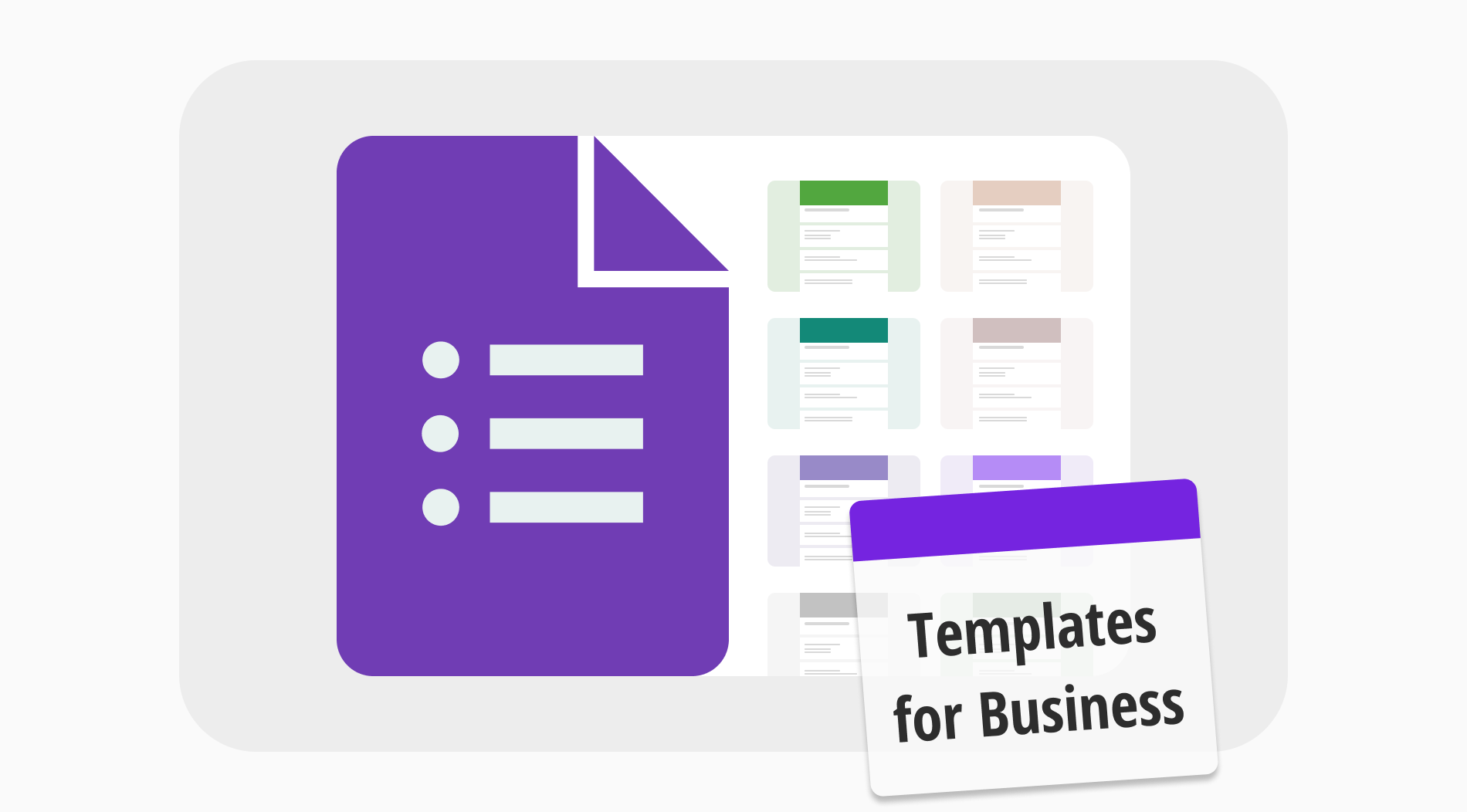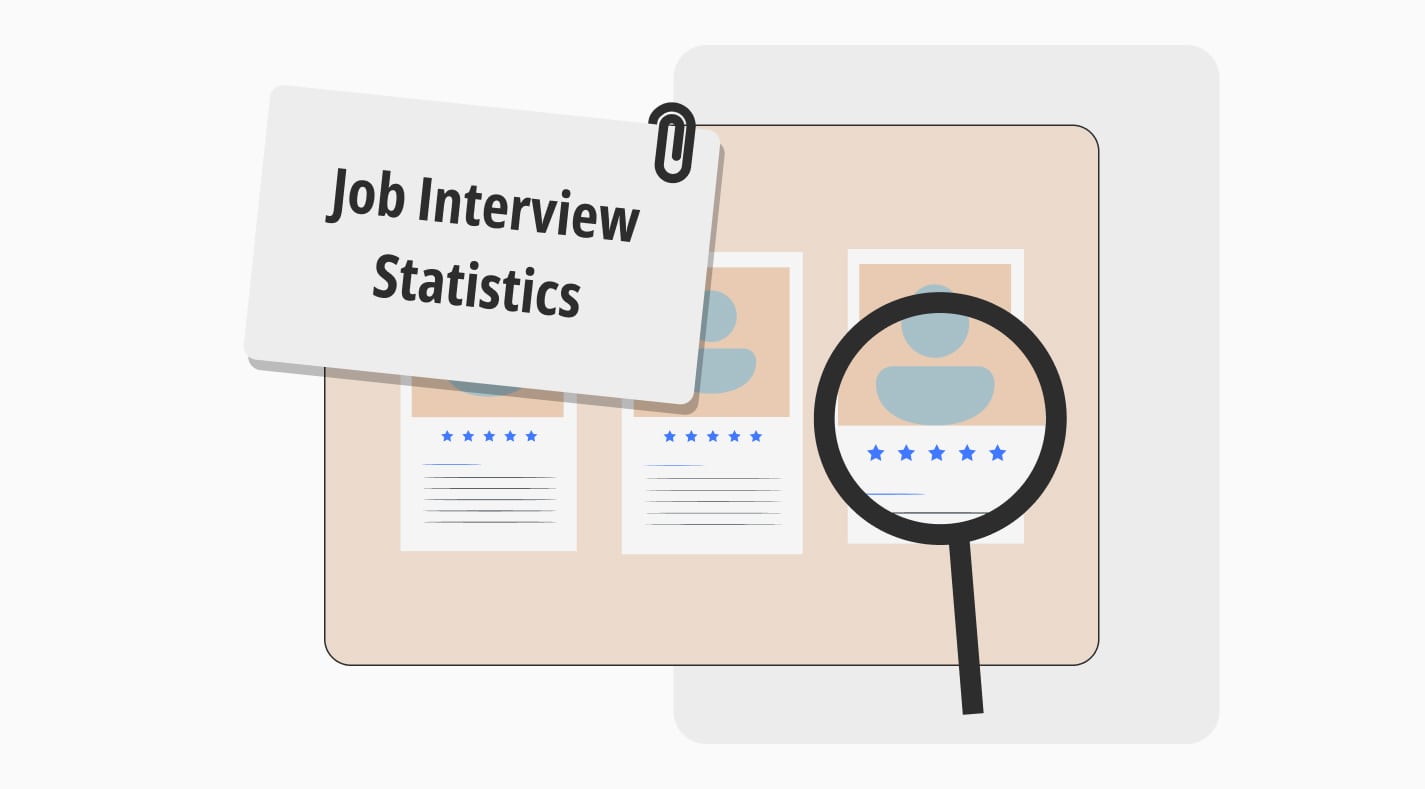
The labor market is based on competition. The recruitment process can be complex and confusing if you are an employer looking for a new employee. Job interviews will allow you to make the right choice when recruiting. Job interviews will help you determine the candidate's qualities and see if they meet your expectations.
This article has brought together 50+ job interview statistics you need to check out to get ideas. You will also get an insight into why you need statistics in the first place. Through this article, you can ensure a successful recruitment process in your company. If you want to know more about job interview statistics for 2024, let's move on to our article about job statistics.
Why do you need statistics?
Every type of industry should benefit from statistics. Statistics are an essential tool to help you move your organization forward. They allow you to make informed decisions. It shows you what is happening in the world around you. Thanks to statistics, you can benefit from the experiences of people who have been through the same path. Statistics can also guide you with the following:
- Identifying the causes of problems and finding solutions
- Using data to take more strategic approaches
- Setting the right goals for your organization
- Making comparisons and inferences between data
- Understanding your audience better
In conclusion, statistics are vital for companies, and every company that wants to achieve its goals should use them. Statistics guide you through the data medium and help you make informed choices. Now, we can move on to our 50+ job statistics that will guide you in your recruitment process.
Highlighted statistics about job interviews
Reading statistics about job interviews can help you manage and improve recruitment processes more effectively in your company. These statistics can also help you make your job interviews more favorable for your potential employees. These positive experiences are important for your company's reputation. You can find the highlighted statistics about job interviews in the list given below:
- On average, 118 people apply for a job. Twenty percent of the 118 applicants (about 24 people) are called for an interview (Forbes).
- The duration of an interview procedure might range from 24 to 38 days on average (TeamStage).
- Interviews are "very valuable," according to 94% of hiring professionals when it comes to selecting candidates with the best fit (Criteria).
- 50% of interviewers believe that a candidate can be eliminated for a job based only on how they behaved, dressed, or entered the room (Twin).
- Every job offer receives 250 applicants on average. Only one of these applicants gets hired after four to six are invited for interviews (LinkedIn).
- According to a survey, 81% of job seekers report that a positive candidate experience during recruitment influenced their decision to accept an offer (CareerPlug).
- Video interviews are now used in the employment process by 67% of recruiters. This shows a 49% increase from the previous year (Utilities One).
50+ Insightful statistics to get ideas about job interviews
If you are a recent graduate looking for a job or an employer looking to add new members to your team, these statistics are for you. You can explore the subject in more detail with the assistance of the categorized statistics. Here are 50+ job interview statistics in different categories to get ideas:
General job interview statistics
General job interview statistics will give you an overview of the process without getting into too much detail. Having a broad perspective on job interviews will ensure clarity before you get down to other details. Here are some general statistics about job interviews:
1. 36% of employers are looking for multi-tasking skills, 31% for initiative, 21% for creative thinking, and 12% for something else in the candidate (Twin).
2. On average, 118 people apply for a job. Twenty percent of the 118 applicants (about 24 people) are called for an interview (Forbes).
3. More than 50 percent of employers report that the average number of interviews before making an offer is three (MRINetwork).
4. Only 2% of job applicants are selected for an interview (Workopolis).
5. 47% of employers said they would not offer a job to a candidate who did not have enough information about the company (Twin).
6. In the UK, candidates spend an average of £52 on travel and overnight accommodation when asked for a face-to-face job interview (Barclay Simpson).
7. The duration of an interview procedure might range from 24 to 38 days on average (TeamStage).
8. After submitting an application for a job, 40% of candidates expect to hear from the employer within six days at most (Cronofy).
9. Interviews are "very valuable," according to 94% of hiring professionals when it comes to selecting candidates with the best fit (Criteria).
10. Only 41% of candidates have ever received feedback, even though 94% of candidates expect to get feedback after a job interview (LinkedIn).
11. 93% of candidates report feeling anxious before a job interview (Mail Online).
12. On average, interviews last 40 minutes. Following that, it often takes one day to two weeks to hear back from the employer (Forbes).
13. Two interview phases typically comprise the job interview process (StandOut CV).

💡If you are curious about more statistics, you can check our 50+ internship statistics to get ideas.
First impression in job interview statistics
First impressions are critical in every aspect of life. The first impression you give to the other party in a job interview can ensure that the interview ends positively. Whether you are an employer or a job seeker, you should pay attention to this issue to get a positive result. Here are the first impression job interview statistics:
14. 33% of 2,000 hiring managers decide whether to hire someone within the first 90 seconds (Twin).
15. Not dressing appropriately for an interview can be a reason for rejection for almost 1 in 4 recruiters (CareerBeacon).
16. First impressions are 55 percent visual, 38 percent vocal, and 7 percent verbal (LinkedIn).
17. 50% of interviewers believe that a candidate can be eliminated for a job based only on how they behaved, dressed, or entered the room (Twin).
18. In a job interview, eye contact should be made 60 to 70 percent of the time (InterviewFocus).
19. 35% of recruiters consider unprofessional email addresses to be deal breakers, and 77% view typos and poor language as such (Legaljobs).
20. During a job interview, candidates have just 7 seconds to make a positive first impression (TeamStage).
21. About 40% of interviewers said they did not move on with a candidate because of their lack of confidence (Twin).
22. 55% of employers demand smart-casual clothing, 19% have no dress-code restrictions at all, and 26% require a formal dress code for interviews (StandOut CV).
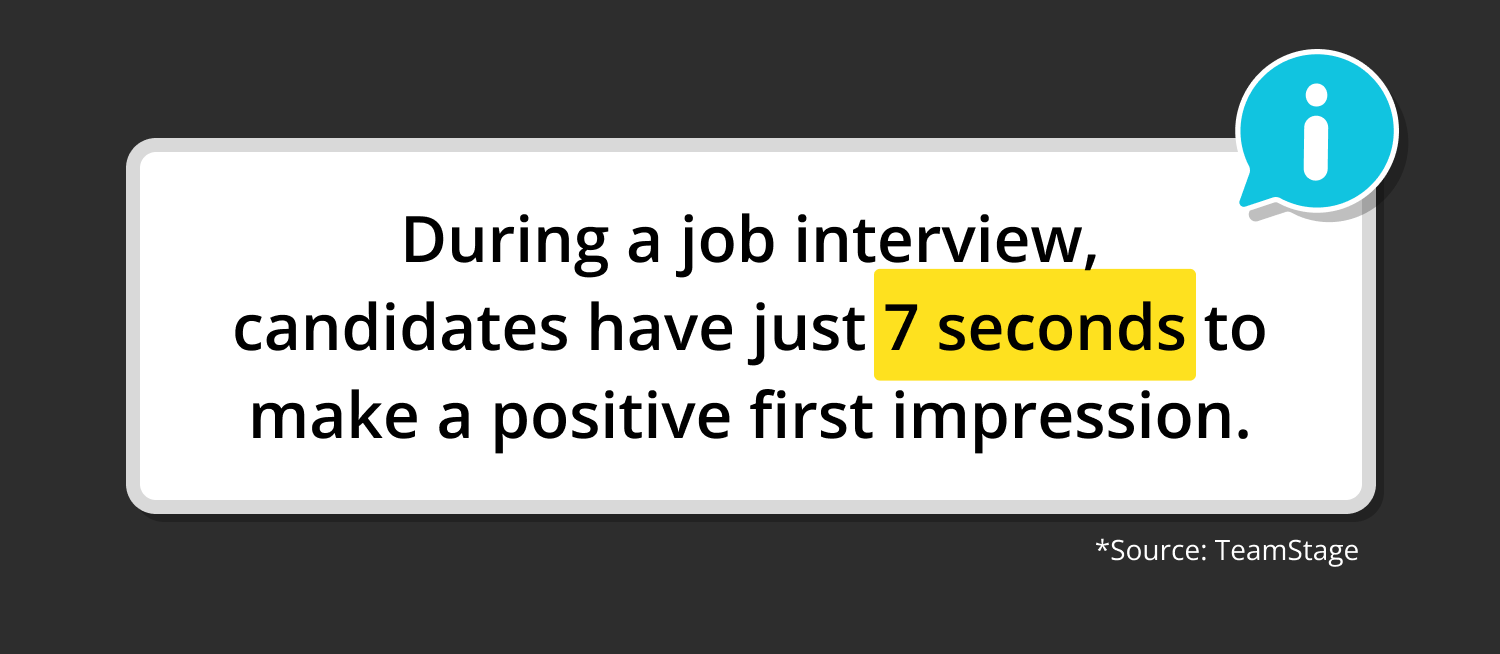
Source: TeamStage
Hiring statistics
Job interviews determine whether a candidate will be hired. Therefore, it will be useful for you and your organization to examine hiring statistics in addition to job interview statistics. If you are looking for new members for your organization, it is time to take a look at hiring statistics:
23. In 2012, 56% of all employers stated that a candidate declined their job offer (Forbes).
24. Hiring new employees costs businesses $4,129 (GoRemotely).
25. In the hiring process, 54% of French candidates believe that personal contact is the most crucial component, compared to 53% in Germany, 29% in the UK, and only 18% in the United States (Cronofy).
26. Approximately 56% of candidates accept an offer made by an employer (Jobvite).
27. According to the survey made by CareerPlug, 45% of candidates stated that they did not hear from the employer after the interview and were ignored (CareerPlug).
28. The average hiring process takes three to four weeks in all industries, and 25% of recruiters say they can fill unfilled positions in less than two weeks (Yello).
29. The hiring procedure takes 42 days on average (TeamStage).
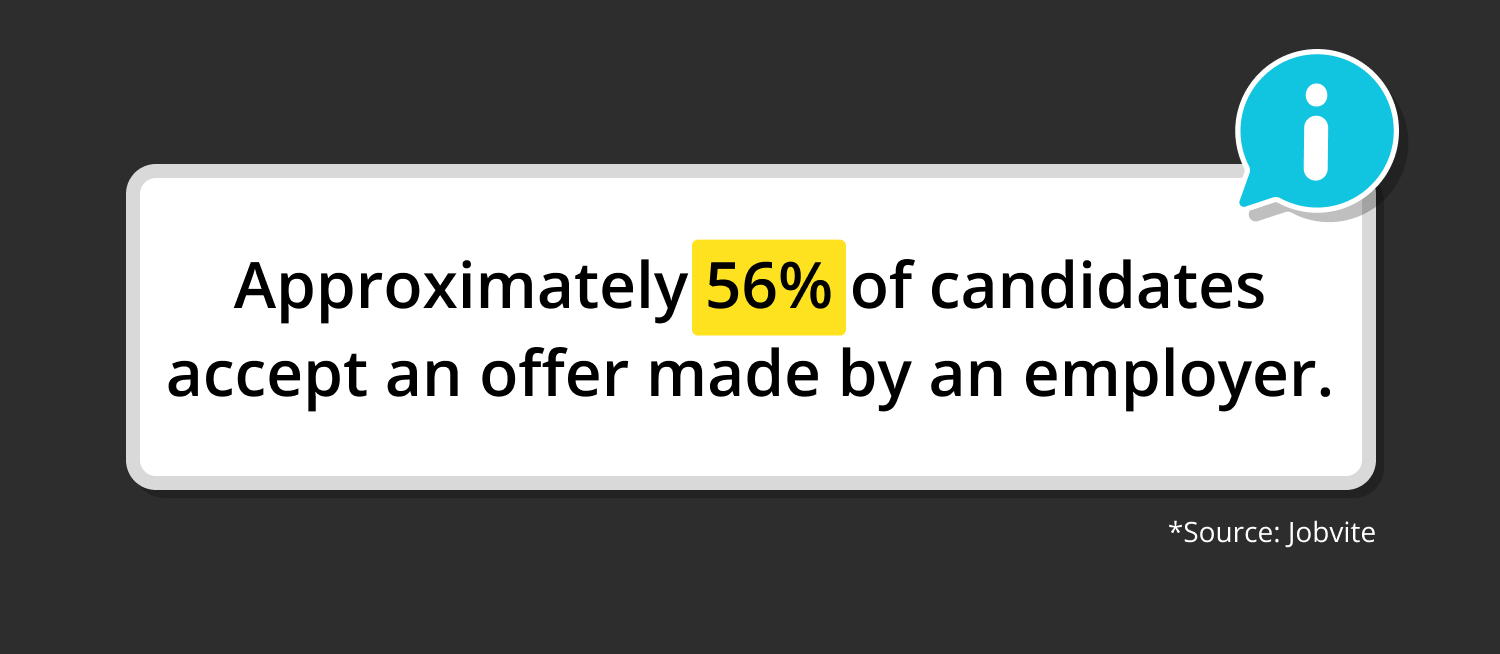
Source: Jobvite
Success & failure rates for recruitment
Whether the recruitment will succeed is determined at the end of the interviews with candidates. Reading success and failure rates for recruitment allows you to see and compare different scenarios. Here are success and failure rates for recruitment to get an insight:
30. Every job offer receives 250 applicants on average. Only one of these applicants gets hired after four to six are invited for interviews (LinkedIn).
31. Recruiters believe that the most common time for job offers to be turned down is between 1 and 8 weeks following the first interview. This is enough time for most candidates to consider and choose another option (MRINetwork).
32. Employers believe that 75% of applicants for a particular role are not qualified for that role (Workopolis).
33. Compared to 53% in Germany, 52% in the UK, and 52% in France, 67% of candidates in the US said they would not wait more than six days for an interview (Cronofy).
34. According to a survey, 81% of job seekers report that a positive candidate experience during the recruitment process influenced their decision to accept an offer (CareerPlug).
35. In 2022, businesses missed more than half of their recruiting targets on average (Goodtime).
36. 60% of recruiters frequently lose candidates before setting up an interview (Yello).
37. The failure rate in the recruitment process is 50% and occurs at all job levels (Visier).
38. Even after 10 attempts, 38.3% of candidates receive no invitation to an interview (Mail Online).
39. One in five applicants declined a job offer because it took too long after the job interview (StandOut CV).

💡If you want to learn about how important employee feedback is, check our 30+ insightful employee feedback statistics.
Video conference statistics
Nowadays, business meetings over video conferences have become very common. In the future, it may become even more widespread and replace face-to-face job interviews. If you are an employer who wants to keep up with the times, you should definitely take a look at these statistics. Here are some video conference statistics:
40. The duration of a video interview can vary between 15 minutes to 90 minutes (indeed).
41. According to a survey of 506 organizations, 47% of them use video interviews to speed up the hiring process (Forbes).
42. If an applicant moves on to the video interview phase, less than half of companies will still need a face-to-face interview in 2023 (StandOut CV).
43. 66% of remote job applicants will apply more frequently if video interviews are allowed (Utilities One).
44. In Cronofy's survey of 6500 candidates worldwide, 70% of candidates reported that their interviews were face-to-face (Cronofy).
45. Increased diversity in the applicant pool is reported by 84% of companies using virtual interviews (Withe).
46. Only 12% of hiring managers claim to use AI in their hiring procedures (Criteria).
47. An electronic system that effectively conducts the interview process is preferred by 62% of candidates over lengthy back-and-forth communication (Cronofy).
48. The biggest challenge for recruiting managers in the coming year is the limitations of current recruitment technology (Goodtime).
49. Video interviews are now used in the employment process by 67% of recruiters. This shows a 49% increase from the previous year (Utilities One).
50. 90% of companies would not require any face-to-face interviews for remote jobs (StandOut CV).
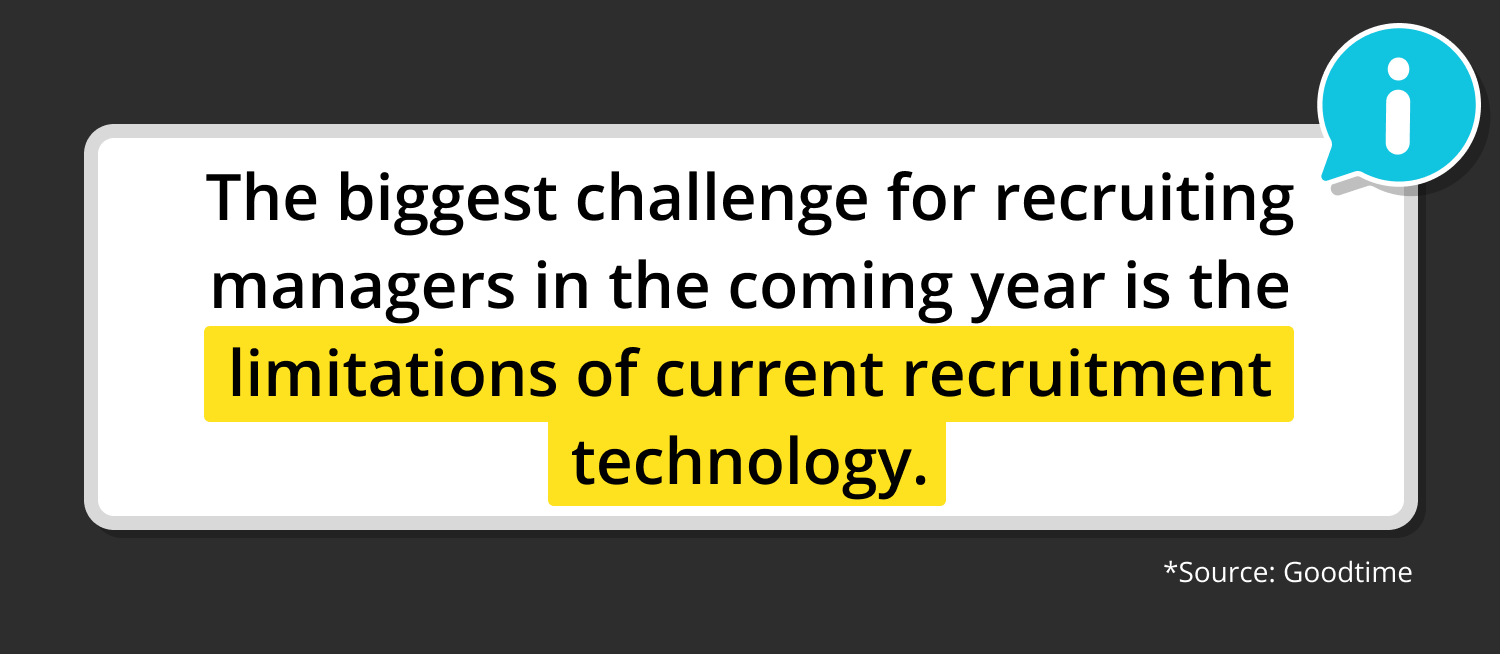
Source: Goodtime
Final words
In this article, we shared some crucial statistics about job interviews. Categorized statistics on job interviews will help you learn the subject in detail. By analyzing these statistics, you can manage your recruitment process better and contribute to your company's success. You can make job interviews a positive experience for your applicants and strengthen your team with the right teammates.
We have compiled 50+ job interview statistics to help you grow your company and provide you with more accurate information about the topic. Now that you know enough about job interviews, you can make better plans for your company!
Fatih is a content writer at forms.app. He is also a translator and interpreter. Fatih loves reading and writing. He is passionate about exercising and traveling. His specialties are surveys, statistics, and translation.



 8 min ler
8 min ler